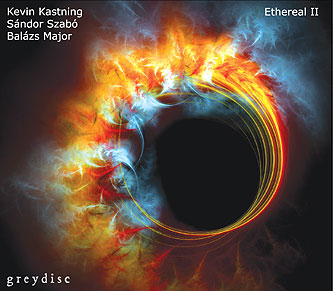 For their 2018 album, Kevin Kastning and Sándor Szabó
enlist the sounds of percussionist Balász Major and
the net result is Ethereal II. The second in
a series of albums featuring Kastning and Szabó that began
earlier in 2018 with the release of Ethereal I, this second
Ethereal album is just as dazzling sounding, if not better,
than the first. The addition of Balász on drums and
percussion completes the sonic structure and also echoes the Kastning
/ Major CD release of Kismaros from mid 2018. The prolific
nature of Kevin Kastning, as both a guitarist and composer notwithstanding,
serves to underscore the brilliant fretboard moves in play on Ethereal
II. Recorded both in Kastning’s Boston-area Traumworld studios
and in Sándor Szabó’s studio in Hungary, Ethereal
II merges Kastning’s unique 36-string Double Contraguitar,
his 30-string Contra-Alto guitar as well as his acoustic piano with
Sándor’s processed electric guitars. The crafty guitar
work and musical insight of these groundbreaking artists reaches new
levels of sonic intrigue, while the drums and percussion of Balász
completes the wide-ranging musical imagination depicted on Ethereal
II. Guitar purists may question the ultra spontaneity and avant-garde
nature of Kastning and Szabó’s music, yet there’s
no denying the expertise with which these two unique musicians execute
their performances on Ethereal II as well as on various other
projects and recordings they’ve recorded and released on Kastning’s
Greydisc label—a fine American label following in the footsteps
of other avant-garde outlets such as the Germany based ECM label.
Like ECM, Greydisc offers the listener a range of boldly executed,
and sonically rewarding releases that combine high levels of improvised
music with a definite flair for the unusual. One of the finest Greydisc
CD releases to date, Ethereal II sets yet another high standard
of musical dialogue from the skillful trio of Kastning, Szabó
and Major. www.kevinkastning.com
/ www.sandorszabo.com
/ www.balazsmajor.com
For their 2018 album, Kevin Kastning and Sándor Szabó
enlist the sounds of percussionist Balász Major and
the net result is Ethereal II. The second in
a series of albums featuring Kastning and Szabó that began
earlier in 2018 with the release of Ethereal I, this second
Ethereal album is just as dazzling sounding, if not better,
than the first. The addition of Balász on drums and
percussion completes the sonic structure and also echoes the Kastning
/ Major CD release of Kismaros from mid 2018. The prolific
nature of Kevin Kastning, as both a guitarist and composer notwithstanding,
serves to underscore the brilliant fretboard moves in play on Ethereal
II. Recorded both in Kastning’s Boston-area Traumworld studios
and in Sándor Szabó’s studio in Hungary, Ethereal
II merges Kastning’s unique 36-string Double Contraguitar,
his 30-string Contra-Alto guitar as well as his acoustic piano with
Sándor’s processed electric guitars. The crafty guitar
work and musical insight of these groundbreaking artists reaches new
levels of sonic intrigue, while the drums and percussion of Balász
completes the wide-ranging musical imagination depicted on Ethereal
II. Guitar purists may question the ultra spontaneity and avant-garde
nature of Kastning and Szabó’s music, yet there’s
no denying the expertise with which these two unique musicians execute
their performances on Ethereal II as well as on various other
projects and recordings they’ve recorded and released on Kastning’s
Greydisc label—a fine American label following in the footsteps
of other avant-garde outlets such as the Germany based ECM label.
Like ECM, Greydisc offers the listener a range of boldly executed,
and sonically rewarding releases that combine high levels of improvised
music with a definite flair for the unusual. One of the finest Greydisc
CD releases to date, Ethereal II sets yet another high standard
of musical dialogue from the skillful trio of Kastning, Szabó
and Major. www.kevinkastning.com
/ www.sandorszabo.com
/ www.balazsmajor.com
mwe3.com presents an interview with
Kevin Kastning, Sándor Szabó and Balázs Major
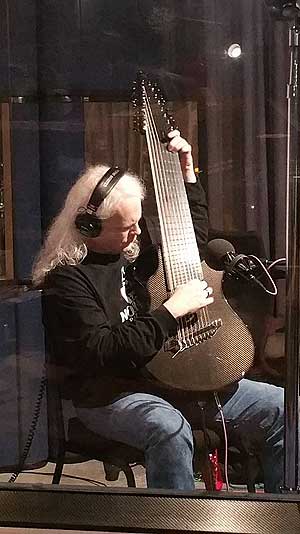 mwe3:
How is Ethereal II an extension of the Ethereal I album
which was released early in 2018? Would you say the new album moves
forward or in different directions from Ethereal I in both
sound and scope and how does the addition of Balázs Major on
drums and percussion alter the sound?
mwe3:
How is Ethereal II an extension of the Ethereal I album
which was released early in 2018? Would you say the new album moves
forward or in different directions from Ethereal I in both
sound and scope and how does the addition of Balázs Major on
drums and percussion alter the sound?
Kevin Kastning: It is indeed a continuation. Ethereal II
is different in a few ways. Sándor is playing electric guitar
with processing. Balázs is playing full drum kit on most tracks,
and this is the first time we’ve recorded together with him on
kit. And I am on piano on a couple of pieces. Additionally, it has
been six years since our last trio record, and in that time we’ve
all continued to grow and evolve as artists.
Sándor Szabó: From my part the extension happened
in two fields, musically and in sound. The records I make are not
only an act to make the music, but also to create art in its sound.
This means that I do not only record, mix and master the music but
I illustrate the instruments in the stereo space and make them more
expressing. I noticed that the modern music with a few exceptions
is not so demanding in creating real stereo experience, they do not
use the space in its depth how I do it. Though the Ethereal series
is especially dedicated to this concept, adding Balázs Major
to this project, the illustration became even more detailed and accentual.
With his playing we have one more dimension on the Ethereal II
in sound and in music, as well.
Balázs Major: I hope that with my presence I managed
to influence the Ethereal II, which is kind of continuation
of the previous album. In my former Greydisc albums I played hand
percussion, but this is the first album where I play a full drum set.
My aim was to support the Ethereal concept, with a new playing style,
which completely differs from trendy drumming can be heard in similar
music. For me the drum is a whole orchestra, a huge potential for
creating colors, moods, tensions. All the elements of my drum set
are tonally tuned.
mwe3: The liner notes of Ethereal II mentions that the
album was recorded late 2017 and early 2018 in both Hungary and in
Massachusetts. Can you tell us which tracks were recorded in both
locations and did recording in one location change in both Europe
and the O.S. change the sound or vision of the particular track? Balázs
said that he recorded his parts in a “remote” way. Is that
the way Ethereal II was made?
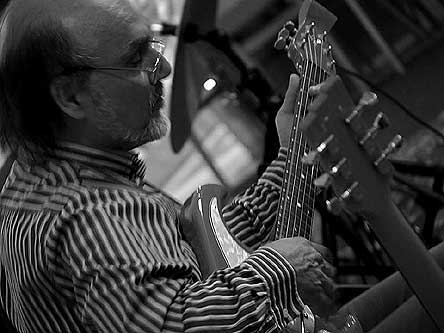 Kevin
Kastning: Yes, we tried tracking this one remotely, and I think
it turned out quite well. So much so that we’ll be doing more
work in this manner. I think we’d all prefer to be in the same
studio at the same time and tracking live together, but when you live
in different countries, that’s not always possible. Tracking
remotely is a very effective alternative. It enables us to continue
our recording work even if we are not in the same country and in the
same studio.
Kevin
Kastning: Yes, we tried tracking this one remotely, and I think
it turned out quite well. So much so that we’ll be doing more
work in this manner. I think we’d all prefer to be in the same
studio at the same time and tracking live together, but when you live
in different countries, that’s not always possible. Tracking
remotely is a very effective alternative. It enables us to continue
our recording work even if we are not in the same country and in the
same studio.
Sándor Szabó: Well, the method of building the
music was very similar as on the Ethereal I. We had prerecorded
tracks mostly from Kevin in his studio in Massachusetts and then I
composed and overdubbed further layers in my studio in Hungary. As
for the drum and percussion recording, they made in Hungary in a concert
hall and both Kevin and I overdubbed our layers on it. So I can answer
to you that all the tracks made both in Hungary and Massachusetts.
This recording was made in a 21st Century way in a “remote”
way, due to the internet. We sent the high resolution sound files
to each other via internet.
Balázs Major: For me the great challenge was to start
to build a piece with my playing which means that the drum was recorded
first. I had to imagine a composition and to play a drum part. This
method is quite unusual, because my drum part was not composed in
advance. I had some ideas and I formed them into an improvised texture.
I did not get musical instruction as in the previous recordings. I
had a total freedom, which is very inspiring but I missed Sandor’s
and Kevin’s presence. The fact that the drum was recorded separately
did not change the sound. Sandor did a great job with mixing and mastering.
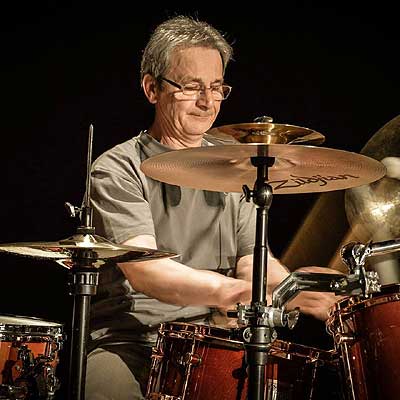 mwe3:
Do you feel that the albums you’ve released on Greydisc are gaining
you more popularity among the more open-minded progressive music fans
and can you contrast that with your further inroads in the neoclassical,
jazz and also the avant-garde world?
mwe3:
Do you feel that the albums you’ve released on Greydisc are gaining
you more popularity among the more open-minded progressive music fans
and can you contrast that with your further inroads in the neoclassical,
jazz and also the avant-garde world?
Kevin Kastning: Most of the albums of mine from the past 7
or 8 years are always reviewed by Progression Magazine, which is the
biggest progressive music magazine of which I know. That may be expanding
my and our music a bit in the prog community. As for the other genres
you mention, my work is played on jazz and classical radio programs.
In fact, All About Jazz magazine did a nice article on me last
week. Sometimes not fitting into a single genre can be helpful.
Sándor Szabó: Well, I personally do not think
in popularity. I just do not care, I mean it is not in the first place
in my preferences. Of course it is a good thing if the number of our
fans is increasing with every release. We do not follow trends, we
just play what we feel and hear inside. This is already far enough
to be in contrast with the neoclassical, jazz and also the avant-garde
world. We do not necessarily want to be different of others. Even
we do not intend to do something new. It comes by itself by our attitude
how we think and feel about music.
mwe3: How did your 2018 European tour influence each of your
compositional and performance styles and do you find different levels
of acceptance of your music among audiences in both the U.S. and Europe,
or rather specifically in Hungary? What are the chances of other tour
dates in North America?
Kevin Kastning: I don’t think a single tour impacts my
compositional approach. For me, a tour is more of a vehicle for sharing
your compositional approach. The acceptance of European audiences
is always amazing to me. My music is more well-received there than
in the US. North American tours are tricky, as I don’t know many
US agents. I would be open to a North American tour if the circumstances
were right, but currently there are no plans for it.
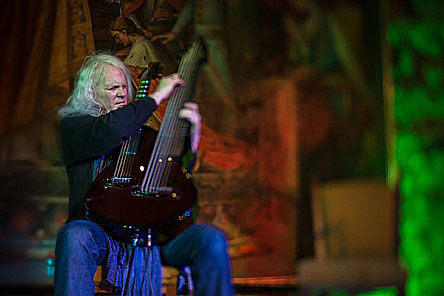 Sándor
Szabó: We have a well-tried attitude how we start to play
and record music. The tour helps to be more in focus and to get closer
to each other mentally. We have an inexplicable chemistry so playing
and creating on concert or recording is so easy and natural.
Sándor
Szabó: We have a well-tried attitude how we start to play
and record music. The tour helps to be more in focus and to get closer
to each other mentally. We have an inexplicable chemistry so playing
and creating on concert or recording is so easy and natural.
As for acceptance, the Hungarian audience is very sensitive and educated,
they are interested in a lot of things. This attitude comes from our
very old and rich music heritage. In the western part of Europe the
acceptance starts to go to the trends which are very strong and it
is difficult to resist to them from the part of the listeners. About
the chances of tour dates in the US I think the music scene is industrialized
so much by agents and agencies that such a special project cannot
get enough attention because our music cannot attract large audience.
This is the first and most important economical parameter and our
music cannot fulfill this. Our music wants to be art and never wanted
to be a consumer product. Nonetheless I experienced that the US audience
would be happy to hear this kind of music, though not in industrial
scale, but it cannot happen because the distribution of concerts happen
through profit oriented agents and agencies.
mwe3: Does Sándor’s guitar work with Kevin
draw further comparisons to the albums Kevin has recorded with Mark
Wingfield? Sounds like they’re equally appealing to fans of your
musical styles.
Kevin Kastning: I think Sándor’s work on electric
guitar would appeal to anyone who likes Mark Wingfield’s work.
I’ve not heard or read of anyone making direct comparisons; while
they are both on electric guitars, I think the similarities end there.
Both artists have their own unique identity.
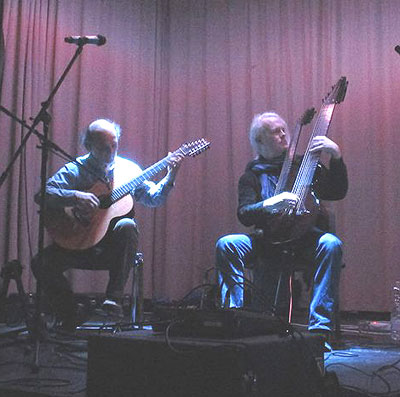 Sándor
Szabó: I think there are common elements in sound because
Mark Wingfield is a very great sound engineer, and our concept meets
in several point. We regularly have very nice discussions and learn
from each other, while both of us has the own specific style. Musically
we have also a great chemistry. We toured and recorded together in
2017 in Hungary. With Kevin, Mark and Balázs we create a nice
artist family and musically we are compatible with each other on recordings.
We all are fans of each other, so it is easy to work.
Sándor
Szabó: I think there are common elements in sound because
Mark Wingfield is a very great sound engineer, and our concept meets
in several point. We regularly have very nice discussions and learn
from each other, while both of us has the own specific style. Musically
we have also a great chemistry. We toured and recorded together in
2017 in Hungary. With Kevin, Mark and Balázs we create a nice
artist family and musically we are compatible with each other on recordings.
We all are fans of each other, so it is easy to work.
Balázs Major: Sándor and Mark are kindred spirits,
but they are different, they have different approach for playing the
instruments and creating their voices. I would not compare them, but
both of them are fantastic personalities in their music.
mwe3: Going back even to the Becoming album you made
back in 2013, you have expanded on your sound, going from purely acoustic
to using electric guitars and piano as well. What directions or other
changes in your music are you considering moving forward both as a
duo and trio and as individual recording artists?
Kevin Kastning: At present, I’m not considering anything
in the way of other instruments in our music. However, I am only here
to serve the music, so if other instruments are required to achieve
a specific goal or an album’s direction, then I suspect we’ll
move to those instruments. I can’t speak for Sándor or
Balázs, but that is how I see it. I am always open to whatever
is required by the music, but I don’t always know in advance
what that will be.
Sándor Szabó: We do not plan too much in advance.
We know that the life brings new things and we just let the process
go by its own. Of course we made kind of “bucket list” like
lute/acoustic guitar recordings, East/West project, etc, but somehow
the life wanted to make the Ethereal project first. Since the Becoming
album so many things happened. After 15 years I started to play
electric guitars and using processing, because it is also a part of
me. For me it is a fantastic field to experiment and create. After
I showed my very first electric album the Echolocation I from 1998
to Kevin, he always asked me why we do not do something similar together.
First I resisted mixing acoustic things with electric, but Kevin convinced
me and now I am astonished on myself, how big fan I have been in blending
electric and acoustic sounds.
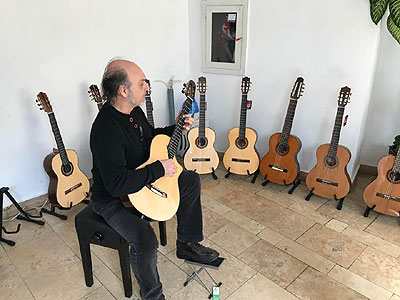 mwe3:
It seems like you are immersed in the nature of the “ethereal”,
calling both albums Ethereal I and now II and there’s
even three tracks called “Ethereality”, I, II and III. How
does the term ethereal impact your music, especially as there’s
two words connected, ether and reality? What can you tell us about
the three “Ethereality” tracks on the album? Are they connected
in some ways or are they each different?
mwe3:
It seems like you are immersed in the nature of the “ethereal”,
calling both albums Ethereal I and now II and there’s
even three tracks called “Ethereality”, I, II and III. How
does the term ethereal impact your music, especially as there’s
two words connected, ether and reality? What can you tell us about
the three “Ethereality” tracks on the album? Are they connected
in some ways or are they each different?
Kevin Kastning: The Ethereal album series project is
based on Sándor being on electric guitars. By titling this
album series as “Ethereal,” it denotes that this is an electric
project with Sándor on electric, and not our usual acoustic
works. The Ethereality series of pieces are different; yet
have a connecting thread, much like movements in a symphony. The terminology
doesn’t impact the music. The music exists on its own, before
titles are determined; the music always comes first. When the music
is completed, then I try to find titles that fit the new music.
Sándor Szabó: Well, in Greydisc releases Kevin
is responsible for giving titles to the tracks. Though my Echolocation
serial is identical conceptually with the Ethereal project, we wanted
another expressing title. The music sounds ethereal, its inner “message”,
and the mood is ethereal, so the title could not be any other than
Ethereal. This is a long term project because the possibilities
are endless and we have enough ideas to extend it more in the future.
So by now the Ethereal serial is more than only album titles, it is
a comprehensive concept for creating music and sound.
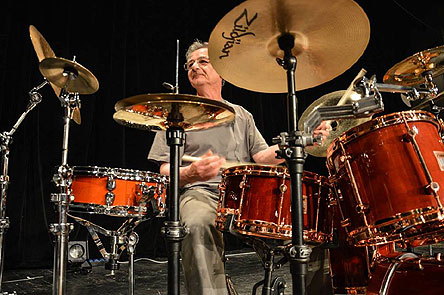 Balázs
Major: When Kevin asked me to take part on the next Ethereal
album first I did not know how I could add something into the Ethereal
project. Of course I had some references, like the Ethereal I and
the Echolocation albums. Sándor pushed me to gather all my
courage to play and sound in a way which is not typical. The Ethereal
can remind the listeners to some ambient music, but in that style
the drum is quite neglected or in the background. Finally my conception
started to form in my head: Given two guitar players, who sometimes
seems to arrive from another galaxy and this was my leading thought.
My aim was to create a musically coequal partnership. After I heard
the full compositions I was completely amazed by the result in sound
and musically, too.
Balázs
Major: When Kevin asked me to take part on the next Ethereal
album first I did not know how I could add something into the Ethereal
project. Of course I had some references, like the Ethereal I and
the Echolocation albums. Sándor pushed me to gather all my
courage to play and sound in a way which is not typical. The Ethereal
can remind the listeners to some ambient music, but in that style
the drum is quite neglected or in the background. Finally my conception
started to form in my head: Given two guitar players, who sometimes
seems to arrive from another galaxy and this was my leading thought.
My aim was to create a musically coequal partnership. After I heard
the full compositions I was completely amazed by the result in sound
and musically, too.
mwe3: The tracks “Portals I” and “Portals II”
are also quite intriguing. There’s a sense of linear movement
that differs from the other tracks and it really combines some great
moods. What can you add about those two cuts?
Kevin Kastning: Balázs is on world hand percussion on
Portals I. And then moves to full drum kit for Portals II.
I think Sándor’s parts propel these pieces forward and
provide that linearity you describe. Balázs brings a lot of
energy and movement to both pieces as well.
Balázs Major: I definitely wanted to create something
unusual which inspires Sándor and Kevin, which give more space
for their compositional approach.
mwe3: Speaking of guitars, Kevin’s 17-string Hybrid Extended
Classical guitar was not featured on album yet? How do you feel that
17-string Hybrid Extended Classical guitar will further change the
sounds in the future?
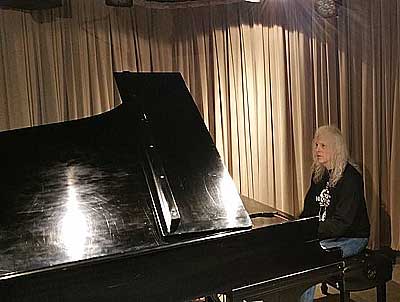 Kevin
Kastning: The 17-string is different from any other of my instruments
in that it is a double-course instrument, but each course consists
of a classical (nylon) string and a steel string; hence the ‘hybrid’
nomenclature in its name. So the instrument blends two entirely different
guitar voices; to my knowledge this has never been done. Its voice
didn’t fit into the Ethereal II recording session directions,
but it could be on another Ethereal series album in the future.
So far, the only record on which it has appeared is my solo record
from earlier this year 17/66. I did use it on some recording
sessions with Mark Wingfield in August of this year. I also used it
on a live radio performance in New York City in August for WNYC and
WFMU. And it will find its way onto my solo albums going forward.
It is really a fantastic instrument and a new voice for sure.
Kevin
Kastning: The 17-string is different from any other of my instruments
in that it is a double-course instrument, but each course consists
of a classical (nylon) string and a steel string; hence the ‘hybrid’
nomenclature in its name. So the instrument blends two entirely different
guitar voices; to my knowledge this has never been done. Its voice
didn’t fit into the Ethereal II recording session directions,
but it could be on another Ethereal series album in the future.
So far, the only record on which it has appeared is my solo record
from earlier this year 17/66. I did use it on some recording
sessions with Mark Wingfield in August of this year. I also used it
on a live radio performance in New York City in August for WNYC and
WFMU. And it will find its way onto my solo albums going forward.
It is really a fantastic instrument and a new voice for sure.
mwe3: How about any comparisons between Ethereal II and
the latest duo album, Kismaros with both Kevin and Balázs?
You were also speaking about another album with this trio and the
addition of yet another electric guitar player, Roland Heidrich. Is
that album also planned for release at some point?
Kevin Kastning: After the spring 2018 European Tour, we were
in the studio for a few days, and recorded some new trio material.
We also recorded some material with Roland in a quartet format, and
it’s very likely that the material from all these sessions will
be released in the coming years. I’m not sure I can make any
direct comparisons between Kismaros and anything else. Kismaros
is in its own category for various reasons.
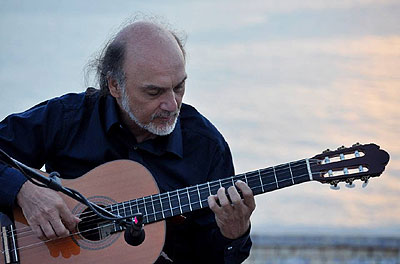 Sándor
Szabó: The Kismaros was born in a live recording situation.
No overdubs, no editing. It just happened and recorded. It is a natural
recording, no electronic soundscapes and effects used. If you hear
similarity it is the ethereal quality of the music they play. This
means that a music can be ethereal not only by its sound but also
by the mood and emotions conveyed in the music through the player’s
musical personality. Yes, we made a quartet recording where the excellent
Hungarian electric guitar player Roland Heidrich took part. This is
a very special valuable recording. We still have some work on it but
as much as I know it is planned to release in the future.
Sándor
Szabó: The Kismaros was born in a live recording situation.
No overdubs, no editing. It just happened and recorded. It is a natural
recording, no electronic soundscapes and effects used. If you hear
similarity it is the ethereal quality of the music they play. This
means that a music can be ethereal not only by its sound but also
by the mood and emotions conveyed in the music through the player’s
musical personality. Yes, we made a quartet recording where the excellent
Hungarian electric guitar player Roland Heidrich took part. This is
a very special valuable recording. We still have some work on it but
as much as I know it is planned to release in the future.
Balázs Major: I also hope that the trio and quartet
recordings will be released in the future. The quartet recording is
very interesting, its elegant minimalism makes it so special. Kismaros
and Ethereal II are very different music, I would not compare
them.
mwe3: Seems like Greydisc is well on the way to becoming an
artistic dynasty of 21st century innovative / avant-garde instrumental
music. How do you see the label developing so far and with a hopefully
long recording cycle ahead of you, how do you see the label’s
future and can you also shed some light on other possible artistic
directions you plan on taking your music in the future?
Kevin Kastning: Thank you for saying so. One thing I see in
the direction of the label is more album releases every year; both
on CD and digital downloads. As for future artistic directions, I
can’t say. For example, three years ago I never would have thought
of any of the Ethereal series; in fact, those are  really
Sándor’s concept. Artistic directions change and grow
and expand over time; often unpredictably. Or at least I hope they
do; I never want to be trapped in one artistic place.
really
Sándor’s concept. Artistic directions change and grow
and expand over time; often unpredictably. Or at least I hope they
do; I never want to be trapped in one artistic place.
Sándor Szabó: Not much new labels can show up
so rich and artistically valuable releases as the Greydisc did in
the last 10 years. The Greydisc goes to a special direction which
cannot be described in simple words. This small independent label
does not follow trend, it produces artistic value independently of
what happens in the music field. As an artist I am very proud to be
a partner of the Greydisc. The Greydisc is still quite young to say
that it created a new genre, but it already created a new sound and
I believe that in some years this label will be significant in the
innovative, creative instrumental music.



